Separators (Spacers)
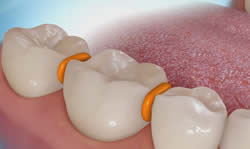
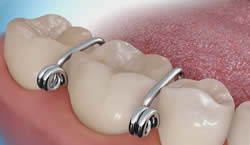
Separators are circular elastic or metal spring devices that are placed between the back teeth. Their function is to ease the teeth apart and create enough space for orthodontic bands to be placed around the teeth at a subsequent appointment. The separators are removed before the bands are placed. Separators may cause some soreness for a few days. A mild analgesic, such as ibuprofen (Advil® or Motrin®) or acetaminophen (Tylenol®), is sufficient to eliminate any discomfort. After separators have been placed, please avoid eating sticky foods or using toothpicks and floss in the area until they are removed.
Bite Plane
 A bite plane is a removable appliance used to decrease the vertical overlap (i.e., overbite) of the front teeth. For optimal results, the bite plane is worn full-time and removed only during meals, while brushing, and while playing sports. When initially placed in the mouth, the bite plane causes separation of the back teeth and prevents the lower front teeth from biting into the roof of the mouth. Over time, the back teeth erupt vertically until they eventually touch. This results in an improved bite in which the front teeth no longer overlap excessively.
A bite plane is a removable appliance used to decrease the vertical overlap (i.e., overbite) of the front teeth. For optimal results, the bite plane is worn full-time and removed only during meals, while brushing, and while playing sports. When initially placed in the mouth, the bite plane causes separation of the back teeth and prevents the lower front teeth from biting into the roof of the mouth. Over time, the back teeth erupt vertically until they eventually touch. This results in an improved bite in which the front teeth no longer overlap excessively.

Palatal Expander (Maxillary Expander)
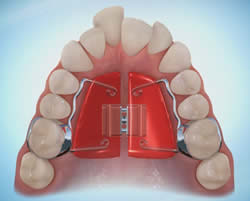 The palatal expander is used to increase the width of the upper jaw. Once the desired expansion is achieved, the appliance is worn for several more months. This allows for the newly formed bone between the two halves of the upper jaw to mature and stabilize.
The palatal expander is used to increase the width of the upper jaw. Once the desired expansion is achieved, the appliance is worn for several more months. This allows for the newly formed bone between the two halves of the upper jaw to mature and stabilize.
You will be given instructions on how to turn your expander and the number of turns that are needed specifically for your treatment.
For troubleshooting with your expander, please click here.
Lower Lingual Holding Arch (LLHA) / E-arch
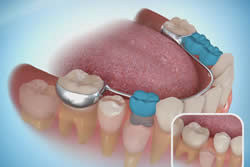 A lower lingual holding arch is used to maximize the space available for the permanent teeth in the lower jaw by preventing the permanent molars from drifting forward when the baby molars are lost.
A lower lingual holding arch is used to maximize the space available for the permanent teeth in the lower jaw by preventing the permanent molars from drifting forward when the baby molars are lost.
An E-arch is similar to a lower lingual holding arch, except an E-arch includes a spring that increases the perimeter of (and increases the space available in) the lower arch.
Forsus™ Appliance
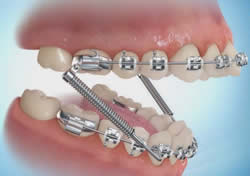 The Forsus™ Appliance is used to decrease the horizontal overlap (i.e., overjet) of the upper and lower teeth. This spring appliance causes the lower jaw and teeth to move forward and the upper molars to move backward. It is used primarily in growing children and is typically worn for nine to 12 months.
The Forsus™ Appliance is used to decrease the horizontal overlap (i.e., overjet) of the upper and lower teeth. This spring appliance causes the lower jaw and teeth to move forward and the upper molars to move backward. It is used primarily in growing children and is typically worn for nine to 12 months.
Herbst® Appliance
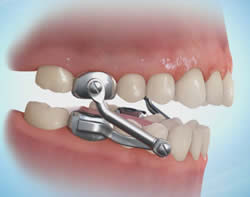 The Herbst Appliance is used to decrease the horizontal overlap (i.e., overjet) of the teeth. This rigid appliance causes the lower jaw and teeth to move forward and the upper molars to move backward. It is used primarily in growing children and adolescents and is typically worn for 9 to 12 months.
The Herbst Appliance is used to decrease the horizontal overlap (i.e., overjet) of the teeth. This rigid appliance causes the lower jaw and teeth to move forward and the upper molars to move backward. It is used primarily in growing children and adolescents and is typically worn for 9 to 12 months.
Distal Jet / Pendulum
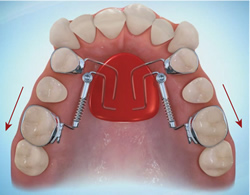
The distal jet and pendulum are spring-loaded appliances that are used to push the upper permanent molars backward. This increases the amount of space available for the teeth developing in front of them. In some cases, it can be an alternative to tooth extraction.
Facemask
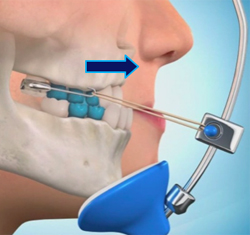
The facemask appliance is used early (as young as age 6) to help bring the upper jaw forward in patients with an underdeveloped upper jaw. These individuals often present with an underbite. Because the lower jaw always outgrows the upper jaw during the pubertal growth spurt, it is crucial to treat this abnormal growth pattern early.
Anchor Pins (Temporary Anchorage Devices, or TADs)

Anchor pins are temporarily inserted into the jaw bones to resist unwanted tooth movements during orthodontic treatment. These devices are used only in select cases and allow for tooth movements that were not possible before the Food and Drug Administration (FDA) approved their use in the United States in the early 2000s.
Elastics (Rubber Bands)
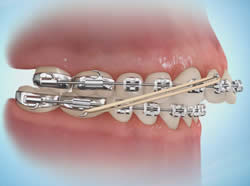
Elastics can be used to assist in closing spaces and/or to improve the fit of your upper and lower teeth. When worn correctly and consistently, they are one of the most important ways in which you can help to keep your treatment on schedule. If you run out of elastics before your next appointment, please call the office and we’ll be happy to send more to you in the mail.
Interproximal Reduction (IPR)

This is a technique where the orthodontist uses a thin, flexible diamond strip to smooth and re-contour the outer enamel layer gently between adjacent teeth. It is an invaluable method to alleviate mild-to-moderate amounts of crowding when expansion and/or extractions are not indicated. It can also be used to reshape teeth to make them look more attractive or compensate for discrepancies in tooth size, thereby allowing upper and lower teeth to fit together properly. Image: IPR series.jpg
IPR is performed in small increments; only about 0.2 mm of enamel is removed at a time. Because there are no nerve endings in enamel, the procedure is painless and does not require any anesthetic.

Clinical studies have demonstrated that IPR does not make teeth more susceptible to cavities. In addition, research has concluded that the gums that support teeth to which IPR has been applied are not more prone to developing gum disease.












